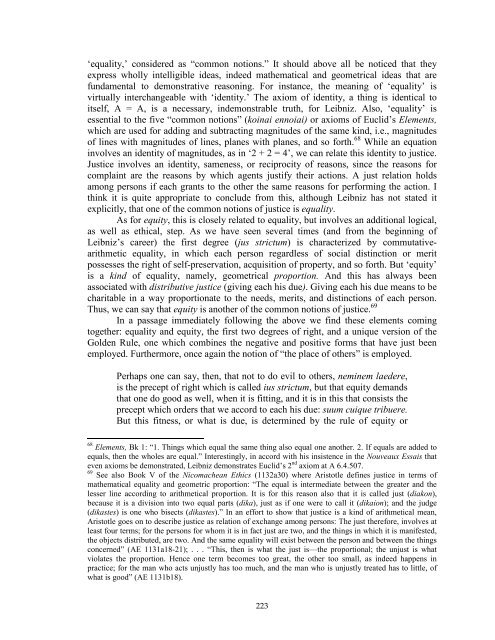Stony Brook University
Stony Brook University
Stony Brook University
You also want an ePaper? Increase the reach of your titles
YUMPU automatically turns print PDFs into web optimized ePapers that Google loves.
‘equality,’ considered as “common notions.” It should above all be noticed that they<br />
express wholly intelligible ideas, indeed mathematical and geometrical ideas that are<br />
fundamental to demonstrative reasoning. For instance, the meaning of ‘equality’ is<br />
virtually interchangeable with ‘identity.’ The axiom of identity, a thing is identical to<br />
itself, A = A, is a necessary, indemonstrable truth, for Leibniz. Also, ‘equality’ is<br />
essential to the five “common notions” (koinai ennoiai) or axioms of Euclid’s Elements,<br />
which are used for adding and subtracting magnitudes of the same kind, i.e., magnitudes<br />
of lines with magnitudes of lines, planes with planes, and so forth. 68 While an equation<br />
involves an identity of magnitudes, as in ‘2 + 2 = 4’, we can relate this identity to justice.<br />
Justice involves an identity, sameness, or reciprocity of reasons, since the reasons for<br />
complaint are the reasons by which agents justify their actions. A just relation holds<br />
among persons if each grants to the other the same reasons for performing the action. I<br />
think it is quite appropriate to conclude from this, although Leibniz has not stated it<br />
explicitly, that one of the common notions of justice is equality.<br />
As for equity, this is closely related to equality, but involves an additional logical,<br />
as well as ethical, step. As we have seen several times (and from the beginning of<br />
Leibniz’s career) the first degree (jus strictum) is characterized by commutativearithmetic<br />
equality, in which each person regardless of social distinction or merit<br />
possesses the right of self-preservation, acquisition of property, and so forth. But ‘equity’<br />
is a kind of equality, namely, geometrical proportion. And this has always been<br />
associated with distributive justice (giving each his due). Giving each his due means to be<br />
charitable in a way proportionate to the needs, merits, and distinctions of each person.<br />
Thus, we can say that equity is another of the common notions of justice. 69<br />
In a passage immediately following the above we find these elements coming<br />
together: equality and equity, the first two degrees of right, and a unique version of the<br />
Golden Rule, one which combines the negative and positive forms that have just been<br />
employed. Furthermore, once again the notion of “the place of others” is employed.<br />
Perhaps one can say, then, that not to do evil to others, neminem laedere,<br />
is the precept of right which is called ius strictum, but that equity demands<br />
that one do good as well, when it is fitting, and it is in this that consists the<br />
precept which orders that we accord to each his due: suum cuique tribuere.<br />
But this fitness, or what is due, is determined by the rule of equity or<br />
68 Elements, Bk 1: “1. Things which equal the same thing also equal one another. 2. If equals are added to<br />
equals, then the wholes are equal.” Interestingly, in accord with his insistence in the Nouveaux Essais that<br />
even axioms be demonstrated, Leibniz demonstrates Euclid’s 2 nd axiom at A 6.4.507.<br />
69 See also Book V of the Nicomachean Ethics (1132a30) where Aristotle defines justice in terms of<br />
mathematical equality and geometric proportion: “The equal is intermediate between the greater and the<br />
lesser line according to arithmetical proportion. It is for this reason also that it is called just (diakon),<br />
because it is a division into two equal parts (dika), just as if one were to call it (dikaion); and the judge<br />
(dikastes) is one who bisects (dikastes).” In an effort to show that justice is a kind of arithmetical mean,<br />
Aristotle goes on to describe justice as relation of exchange among persons: The just therefore, involves at<br />
least four terms; for the persons for whom it is in fact just are two, and the things in which it is manifested,<br />
the objects distributed, are two. And the same equality will exist between the person and between the things<br />
concerned” (AE 1131a18-21); . . . “This, then is what the just is—the proportional; the unjust is what<br />
violates the proportion. Hence one term becomes too great, the other too small, as indeed happens in<br />
practice; for the man who acts unjustly has too much, and the man who is unjustly treated has to little, of<br />
what is good” (AE 1131b18).<br />
223
















